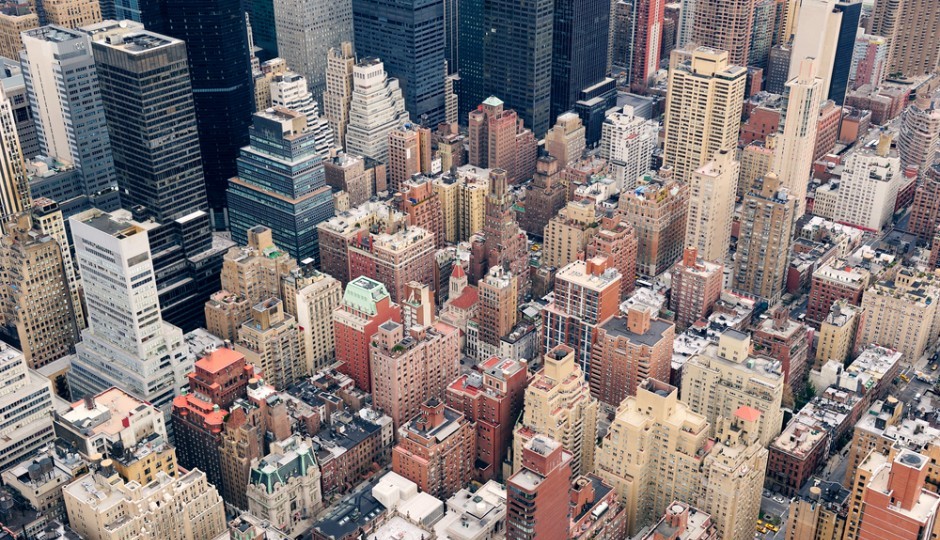How Long Before Center City Is as Dense as Manhattan?

Shutterstock.com
One of the compliments I typically hear about Philadelphia is that “it’s manageable” — less crowded, moving at a slower place, wholly un-claustrophobic. When people say that, they’re typically comparing Philly to New York. Take the Amtrak up to Penn Station and you’ll be hard-pressed for personal space.
No city in the U.S. comes close to Manhattan’s density: 70,000 people per square mile. Not even New York City as a whole comes close to Manhattan: the whole of NYC only has 27,000 people per square mile. And yet, the threat of “Manhattanization” is a frequent topic on real-estate blogs across the country. Curbed Miami even has a search tag called “Manhattanization of Miami.” Some people who cringe at rapid development are using the M-word in much the same way the G-word (gentrification) is used. Both have become catch-all terms for the fear and uncertainty a lot of people have about how quickly some cities are changing. It’s the topic of a compelling interactive post by Shane Phillips at Urban One:
Manhattanization is best described as the fear among some residents of growing cities that if population growth continues unabated, there will be no room left for anything but townhomes, apartments, and pencil-thin skyscrapers. The streets will be overrun with traffic and tourists. Wall Street will move in, balls will drop on live television, chaos will ensue.
Phillips goes on to ask—and answer—an interesting question. How long would it actually take for other U.S. cities to match Manhattan’s density?
His results might surprise you. In order for all five boroughs of New York to match the density of Manhattan, the city’s population would have to double—and then some—reaching 21 million residents. That’s the equivalent of absorbing the population of Los Angeles, Chicago, Houston, Phoenix, San Diego and San Antonio combined. If the city continues to grow at the same rate in did between 2000 and 2010, it’d take 460 years for the whole of New York to resemble Manhattan.
How about Philly? Well, you can go ahead and fire up your cryogenic sleep machine, because it would take another 3,269 years for the whole of Philadelphia to achieve Manhattan-scale density. Right now, Philly’s density stands at just over 11,000 people per square mile. To reach 70,000, the population would have to grow six-fold, up to 9.4 million people. That seems … unlikely.
Nobody really worries about Chestnut Hill morphing into Manhattan though. When people think about the Manhattanization of Philadelphia, they’re thinking about Center City and the neighborhoods that surround it.
Philadelphia’s true downtown—from Vine to Pine, river to river—is already quite dense by the standards of most U.S. cities. About 29,000 people per square mile in core Center City. And if growth continues in Center City’s core at the same rate it did between 2000 and 2010—which is, of course, hardly a sure bet—downtown Philly would become as dense as Manhattan is right now sometime around the year 2065.
Greater Center City—defined as the area between Tasker and Girard, river to river—is growing more slowly and is less dense to begin with. It wouldn’t reach Manhattan-level population density until 2276 (right in time for the country’s quincentennial!).
It’s important to realize these calculations are purely a thought experiment. No city will come close to Manhattanization—even the other New York boroughs—anytime soon, because when populations grow and cities become more dense, deterrents to uninhibited growth quickly emerge: regulations are put in place, construction costs rise and natural migration patterns spur people to move elsewhere
Indeed, compared to a lot of other more rapidly-growing cities, Philly’s Blade Runner future looks to be far, far away. Using Phillips’ methodology, Washington D.C. and San Francisco would match Manhattan’s density in 388 and 390 years, respectively. Boston would get there in 361 years. Oakland in just 175 years.
Why does Philadelphia lag those other cities so much? Because Philly’s growth rate remains comparatively low, and it covers many more square miles than any of those cities. Sure, Philadelphia is doing a lot better now than it was in the decades it was shedding population, but worries that the city is becoming too dense are misplaced. The takeaway here is that the Manhattanization of Philadelphia is a long way off, if it ever comes at all. Philly remains a big, underpopulated city with more than enough room for growth — whether that’s in Center City or Northern Liberties or West Philly.